Collaborative Path Planning of Multiple AUVs Based on Adaptive Multi-Population PSO
Abstract
:1. Introduction
2. Environmental Setting and Experimental Preparation
2.1. Obstacle Setting of Underwater Environment
2.2. Experimental Preparation of Collaboration of Multiple AUVs
2.2.1. Setting of Multiple AUVs
2.2.2. Constraint of Multiple AUVs
- (1)
- Spatial collaborative constraints
- (2)
- Temporal collaborative constraints
3. Methodological Design of AMP-PSO
3.1. Encoding of Particles and Population
3.2. Design of Follower and Leader Populations in AMP-PSO
3.2.1. Initialization of Follower Populations
3.2.2. Initialization and Updating of Leader Population
- (1)
- As shown in Figure 5a, the best particles of each population were immigrated into a new population, which was considered as the leader population.
- (2)
- As shown in Figure 5b, the immigrated particles and original particles were all updated in the leader population (the updating rules are introduced in Section 3.3.1).
- (3)
- As shown in Figure 5c, the immigrated particles returned to their own follower populations and replaced the worst one.
3.3. Design of Updating Rules in AMP-PSO
3.3.1. Particle Updating in AMP-PSO
3.3.2. Adaptive Parameters of AMP-PSO
3.4. Fitness Definition
4. Numerical Experiments and Simulation Results
4.1. Setting of Computation and Experiment
4.1.1. Computational Environment
4.1.2. Setting of Multiple AUVs Environment
4.1.3. Setting of AUV Motion Environment
4.1.4. Setting of Algorithm Parameters
4.2. Experimental Comparison of Simulation Scenarios
4.3. Discussion of Computing Time
5. Conclusions
Author Contributions
Funding
Institutional Review Board Statement
Informed Consent Statement
Data Availability Statement
Acknowledgments
Conflicts of Interest
References
- Sahoo, A.; Dwivedy, S.K.; Robi, P.S. Advancements in the field of autonomous underwater vehicle. Ocean Eng. 2019, 181, 145–160. [Google Scholar] [CrossRef]
- Guo, X.; Chen, Y.; Zhao, D.; Luo, G. A static area coverage algorithm for heterogeneous AUV group based on biological competition mechanism. Front. Bioeng. Biotechnol. 2022, 10, 845161. [Google Scholar] [CrossRef] [PubMed]
- Hadi, B.; Khosravi, A.; Sarhadi, P. A review of the path planning and formation control for multiple autonomous underwater vehicles. J. Intell. Robot. Syst. 2021, 101, 67. [Google Scholar] [CrossRef]
- Li, H.; Wu, X.; Zhang, Z.; Tan, X.; Pan, Y.; Dai, C.; Luo, D.; Ahmed, A.; Xu, Y. An extended-range wave-powered autonomous underwater vehicle applied to underwater wireless sensor networks. iScience 2022, 25, 104738. [Google Scholar] [CrossRef] [PubMed]
- Cheng, C.; Sha, Q.; He, B.; Li, G. Path planning and obstacle avoidance for AUV: A review. Ocean Eng. 2021, 235, 109355. [Google Scholar] [CrossRef]
- Ahmed, F.; Xiang, X.; Jiang, C.; Xiang, G.; Yang, S. Survey on traditional and AI based estimation techniques for hydrodynamic coefficients of autonomous underwater vehicle. Ocean Eng. 2023, 268, 113300. [Google Scholar] [CrossRef]
- Chen, M.; Zhu, D. A workload balanced algorithm for task assignment and path planning of inhomogeneous autonomous underwater vehicle system. IEEE Trans. Cogn. Dev. Syst. 2018, 11, 483–493. [Google Scholar] [CrossRef]
- Li, J.; Xiang, X.; Dong, D.; Yang, S. Prescribed time observer based trajectory tracking control of autonomous underwater vehicle with tracking error constraints. Ocean Eng. 2023, 274, 114018. [Google Scholar] [CrossRef]
- Xiao, G.; Wang, B.; Deng, Z.; Fu, M.; Ling, Y. An acoustic communication time delays compensation approach for master–slave AUV cooperative navigation. IEEE Sens. J. 2016, 17, 504–513. [Google Scholar] [CrossRef]
- Cao, X.; Yu, A.L. Multi-AUV cooperative target search algorithm in 3-D underwater workspace. J. Navig. 2017, 70, 1293–1311. [Google Scholar] [CrossRef]
- Huang, H.; Zhu, D.; Ding, F. Dynamic task assignment and path planning for multi-AUV system in variable ocean current environment. J. Intell. Robot. Syst. 2014, 74, 999–1012. [Google Scholar] [CrossRef]
- Fang, Z.; Jiang, D.; Huang, J.; Cheng, C.; Sha, Q.; He, B.; Li, G. Autonomous underwater vehicle formation control and obstacle avoidance using multi-agent generative adversarial imitation learning. Ocean Eng. 2022, 262, 112182. [Google Scholar] [CrossRef]
- Blindheim, S.; Rokseth, B.; Johansen, T.A. Autonomous Machinery Management for Supervisory Risk Control Using Particle Swarm Optimization. J. Mar. Sci. Eng. 2023, 11, 327. [Google Scholar] [CrossRef]
- Lin, X.; Tian, W.; Zhang, W.; Zeng, J.; Zhang, C. The leaderless multi-AUV system fault-tolerant consensus strategy under heterogeneous communication topology. Ocean Eng. 2021, 237, 109594. [Google Scholar] [CrossRef]
- Zeng, Z.; Sammut, K.; Lian, L.; He, F.; Lammas, A.; Tang, Y. A comparison of optimization techniques for AUV path planning in environments with ocean currents. Robot. Auton. Syst. 2016, 82, 61–72. [Google Scholar] [CrossRef]
- Youakim, D.; Ridao, P. Motion planning survey for autonomous mobile manipulators underwater manipulator case study. Robot. Auton. Syst. 2018, 107, 20–44. [Google Scholar] [CrossRef]
- Saravanakumar, S.; Asokan, T. Multipoint potential field method for path planning of autonomous underwater vehicles in 3D space. Intell. Serv. Robot. 2013, 6, 211–224. [Google Scholar] [CrossRef]
- Hernández, J.D.; Vidal, E.; Moll, M.; Palomeras, N.; Carreras, M.; Kavraki, L.E. Online motion planning for unexplored underwater environments using autonomous underwater vehicles. J. Field. Robot. 2019, 36, 370–396. [Google Scholar] [CrossRef]
- Cai, W.; Zhang, M.; Zheng, Y.R. Task assignment and path planning for multiple autonomous underwater vehicles using 3D dubins curves. Sensors 2017, 17, 1607. [Google Scholar] [CrossRef] [PubMed]
- Hermand, E.; Nguyen, T.W.; Hosseinzadeh, M.; Garone, E. Constrained control of UAVs in geofencing applications. In Proceedings of the 2018 26th Mediterranean Conference on Control and Automation (MED), Zadar, Croatia, 19–22 June 2018. [Google Scholar]
- Ru, J.; Yu, S.; Wu, H.; Li, Y.; Wu, C.; Jia, Z.; Xu, H. A multi-AUV path planning system based on the omni-directional sensing ability. J. Mar. Sci. Eng. 2021, 9, 806. [Google Scholar] [CrossRef]
- Liu, C.; Lee, S.; Varnhagen, S.; Tseng, H.E. Path planning for autonomous vehicles using model predictive control. In Proceedings of the 2017 IEEE Intelligent Vehicles Symposium (IV), Los Angeles, CA, USA, 11–14 June 2017. [Google Scholar]
- Qian, C. Multiobjective evolutionary algorithms are still good: Maximizing monotone approximately submodular minus modular functions. Evol. Comput. 2021, 29, 463–490. [Google Scholar] [CrossRef]
- Liu, L.; Wang, X.; Yang, X.; Liu, H.; Li, J.; Wang, P. Path planning techniques for mobile robots: Review and prospect. Expert Syst. Appl. 2023, 227, 120254. [Google Scholar] [CrossRef]
- Panda, M.; Das, B.; Subudhi, B.; Pati, B.B. A comprehensive review of path planning algorithms for autonomous underwater vehicles. Int. J. Autom. Comput. 2020, 17, 321–352. [Google Scholar] [CrossRef]
- Sun, Y.; Gu, R.; Chen, X.; Sun, R.; Xin, L.; Bai, L. Efficient time-optimal path planning of AUV under the ocean currents based on graph and clustering strategy. Ocean Eng. 2022, 259, 111907. [Google Scholar] [CrossRef]
- Wang, L.; Liu, L.; Qi, J.; Peng, W. Improved quantum particle swarm optimization algorithm for offline path planning in AUVs. IEEE Access 2020, 8, 143397–143411. [Google Scholar] [CrossRef]
- Zhuo, W.; Longjie, J.; Hongmei, G.; Xiaoning, F. A path planning strategy for data acquisition task using multiple autonomous underwater vehicles. In Proceedings of the OCEANS 2016-Shanghai, Shanghai, China, 10–13 April 2016. [Google Scholar]
- Zhang, J.; Xiang, X.; Li, W.; Zhang, Q. Adaptive Neural Control of Flight-Style AUV for Subsea Cable Tracking Under Electromagnetic Localization Guidance. IEEE ASME Trans. Mech. 2023, 28, 2976–2987. [Google Scholar] [CrossRef]
- MahmoudZadeh, S.; Yazdani, A.M.; Sammut, K.; Powers, D.M. Online path planning for AUV rendezvous in dynamic cluttered undersea environment using evolutionary algorithms. Appl. Soft. Comput. 2018, 70, 929–945. [Google Scholar] [CrossRef]
- Li, G.; Chou, W. Path planning for mobile robot using self-adaptive learning particle swarm optimization. Sci. China Inform. Sci. 2018, 61, 052204. [Google Scholar] [CrossRef]
- Sui, F.; Tang, X.; Dong, Z.; Gan, X.; Luo, P.; Sun, J. ACO+ PSO+ A*: A bi-layer hybrid algorithm for multi-task path planning of an AUV. Comput. Ind. Eng. 2023, 175, 108905. [Google Scholar] [CrossRef]
- Qin, H.; Si, J.; Wang, N.; Gao, L. Fast fixed-time nonsingular terminal sliding-mode formation control for autonomous underwater vehicles based on a disturbance observer. Ocean Eng. 2023, 270, 113423. [Google Scholar] [CrossRef]
- Qin, H.; Chen, X.; Sun, Y. Adaptive state-constrained trajectory tracking control of unmanned surface vessel with actuator saturation based on RBFNN and tan-type barrier Lyapunov function. Ocean Eng. 2022, 253, 110966. [Google Scholar] [CrossRef]
- Liu, C.; Xiang, X.; Duan, Y.; Yang, L.; Yang, S. Improved path following for autonomous marine vehicles with low-cost heading/course sensors: Comparative experiments. Control Eng. Pract. 2024, 142, 105740. [Google Scholar] [CrossRef]
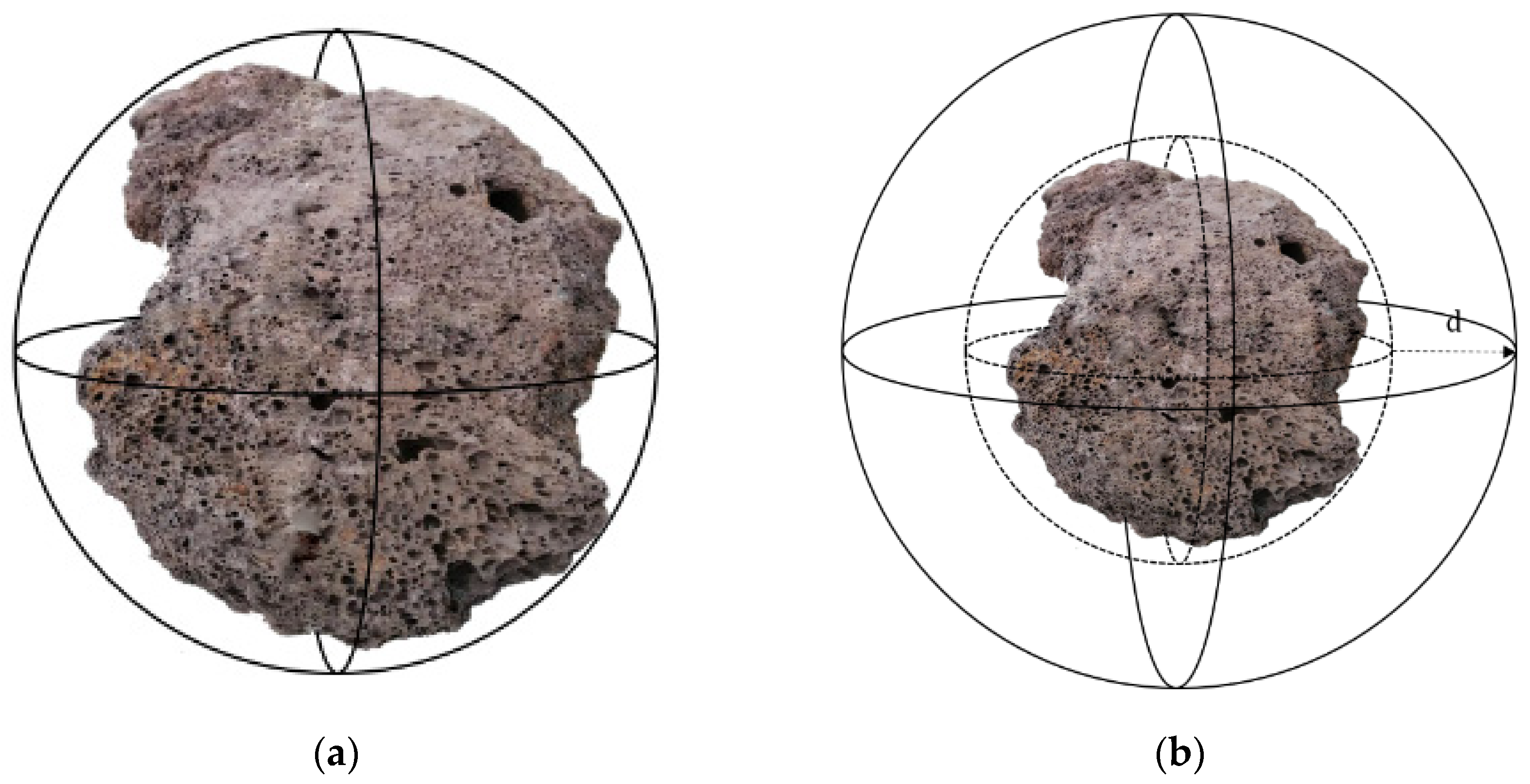




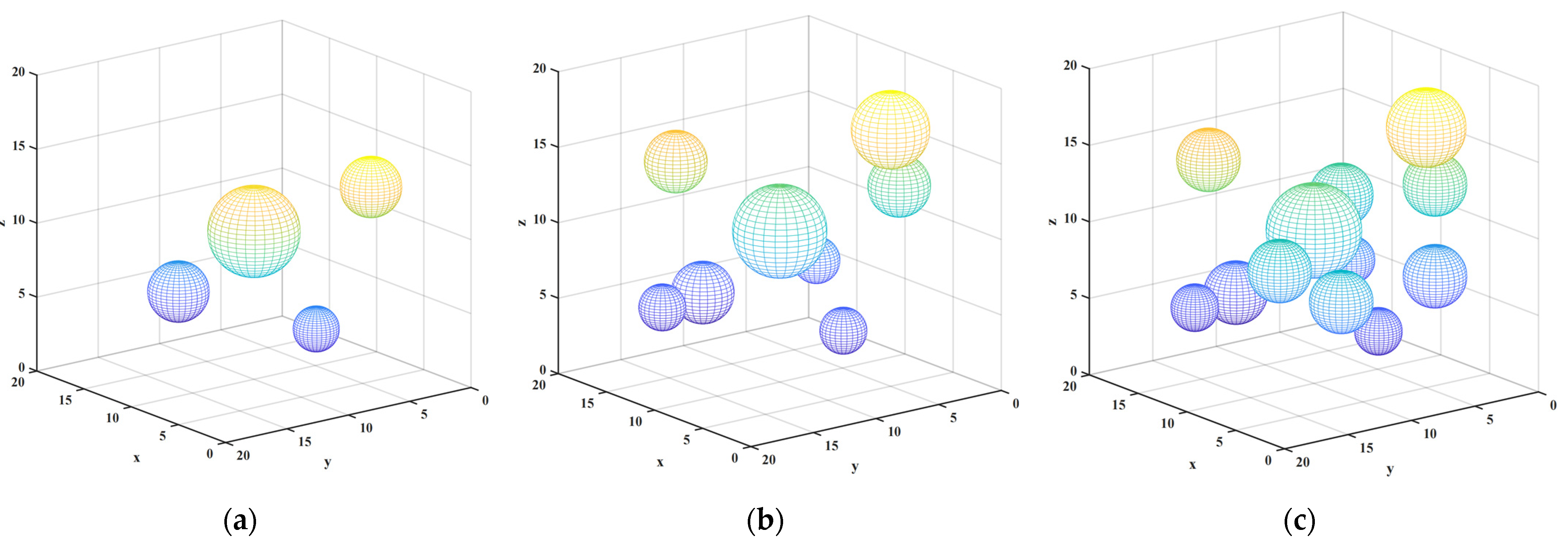

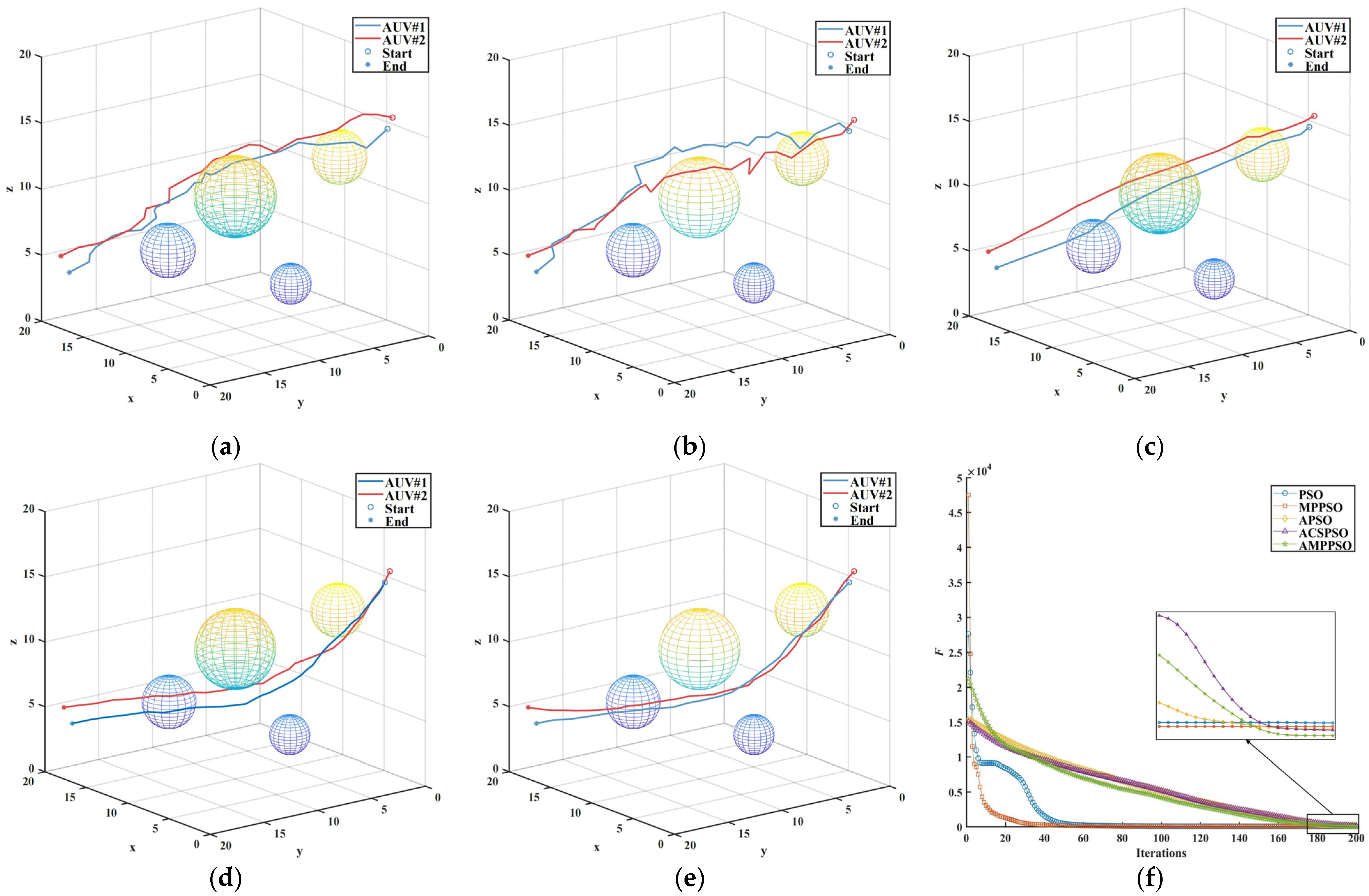


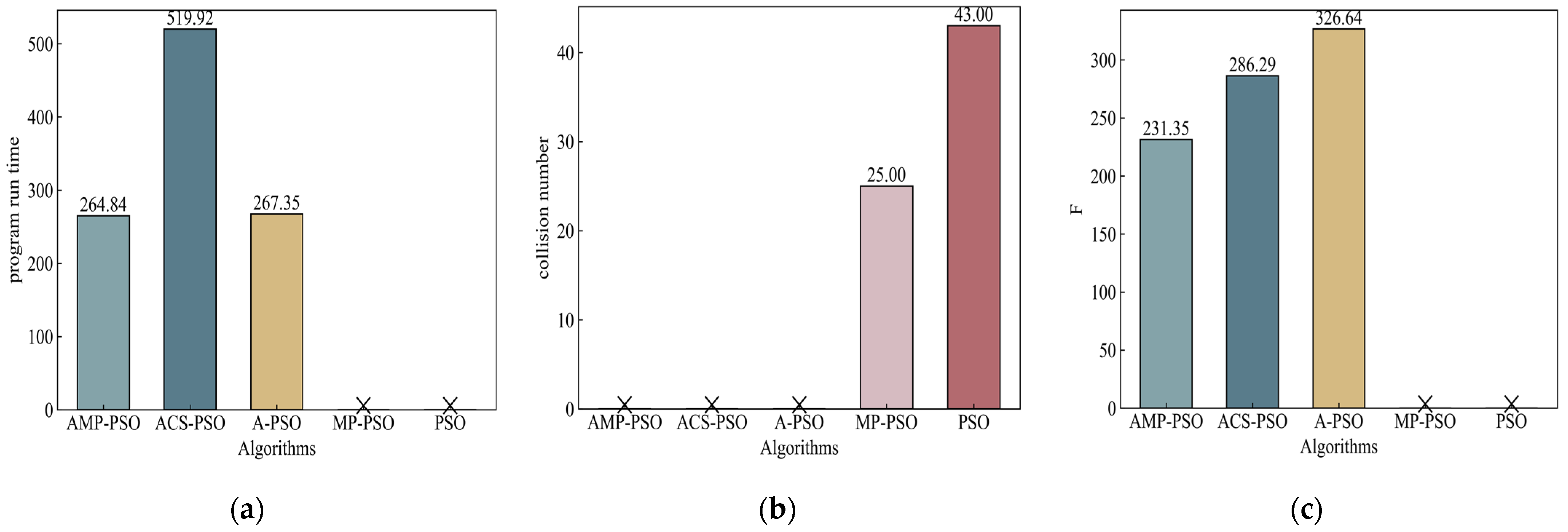
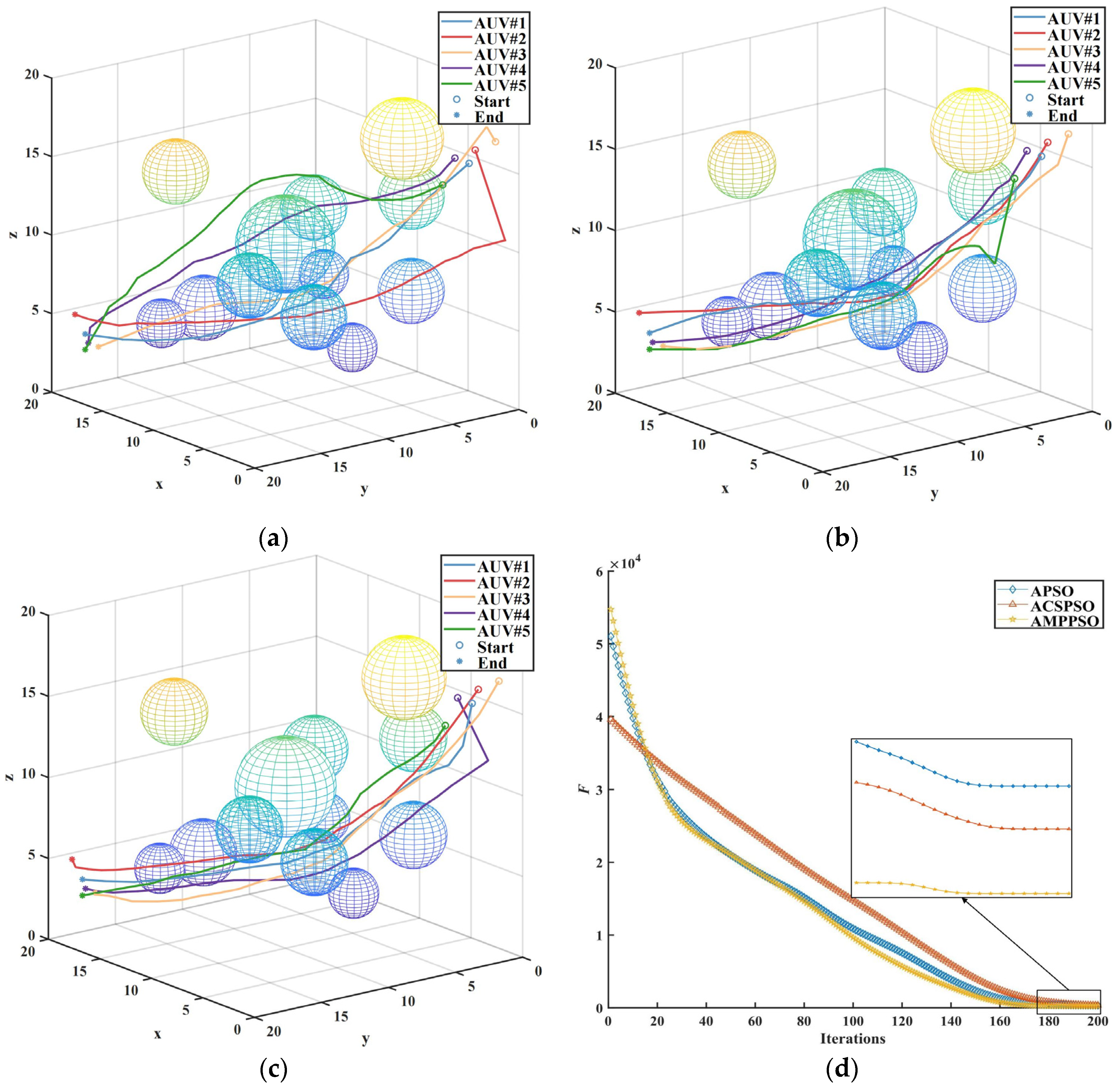
| Reference | Algorithm | Vantage | Limitation |
|---|---|---|---|
| [17] | APF | Efficient and rapid | Susceptible to local convergence optimization |
| [18] | RRT | Reduce costs and optimize performance | High computational cost |
| [19] | GA | Robustness | Computational inefficiency |
| [20] | ERG | Precision and safety | Complexity in implementation |
| [21] | R-Dijkstra, ANSGA | Precision and efficiency | High volume of computation |
| [22] | MPC | Flexibility and precision | Complexity in implementation and high volume of computation |
| [15] | PSO | High-dimensional issues and efficiency | Susceptible to local convergence optimization |
| Obstacle (Abbr.) | Center Point Coordinates | Radius (km) |
|---|---|---|
| hard obstacle #1 (HObs#1) | (10, 10, 10) | 0.3 |
| hard obstacle #2 (HObs#2) | (5, 5, 17) | 0.25 |
| hard obstacle #3 (HObs#3) | (17, 14, 4) | 0.15 |
| hard obstacle #4 (HObs#4) | (15, 4, 10) | 0.2 |
| hard obstacle #5 (HObs#5) | (7, 15, 9) | 0.2 |
| soft obstacle #1 (SObs#1) | (8, 2, 12) | 0.2 |
| soft obstacle #2 (SObs#2) | (6, 8, 4) | 0.15 |
| soft obstacle #3 (SObs#3) | (18, 10, 4) | 0.2 |
| soft obstacle #4 (SObs#4) | (14, 4, 6) | 0.15 |
| soft obstacle #5 (SObs#5) | (13, 16, 15) | 0.2 |
| soft obstacle #6 (SObs#6) | (2, 14, 8) | 0.2 |
| soft obstacle #7 (SObs#7) | (8, 2, 6) | 0.2 |
| AUVs | Starting Point | Ending Point |
|---|---|---|
| AUV#1 | (1, 3, 16) | (18, 19, 4) |
| AUV#2 | (3, 1, 16) | (19, 19, 5) |
| AUV#3 | (1, 1, 17) | (18, 18, 3) |
| AUV#4 | (5, 1, 15) | (19, 18, 3) |
| AUV#5 | (1, 5, 15) | (18, 19, 3) |
| Parameter | Value |
|---|---|
| (knot) | [1.0, 3.0] |
| (s) | 2100, 2300, 2700 |
| (km) | 0.05 |
| (km) | 0.05 |
| (km) | 0.05 |
| 30 | |
| [−35°, 35°] | |
| [−20°, 20°] |
| Parameter | AMP-PSO | ACS-PSO | A-PSO | MP-PSO | PSO |
|---|---|---|---|---|---|
| Population number | 20 | 1 | 1 | 20 | 1 |
| Particle number | 50 | 50 | 50 | 50 | 50 |
| - | - | - | 0.15 | 0.15 | |
| - | - | - | 1.5 | 1.5 | |
| - | - | - | 1.5 | 1.5 | |
| - | - | - | 1.5 | - | |
| Iteration number | 200 | 200 | 200 | 200 | 200 |
| Parameter | AMP-PSO | ACS-PSO | A-PSO | MP-PSO | PSO |
|---|---|---|---|---|---|
| Simple scenario No. 1 | 34.46 s | 77.99 s | 33.68 s | 30.28 s | 35.46 s |
| Complex scenario No. 2 | 96.19 s | 184.39 s | 101.04 s | 98.51 s | 98.37 s |
| Highly complex scenario No. 3 | 264.84 s | 519.92 s | 267.35 s | - | - |
Disclaimer/Publisher’s Note: The statements, opinions and data contained in all publications are solely those of the individual author(s) and contributor(s) and not of MDPI and/or the editor(s). MDPI and/or the editor(s) disclaim responsibility for any injury to people or property resulting from any ideas, methods, instructions or products referred to in the content. |
© 2024 by the authors. Licensee MDPI, Basel, Switzerland. This article is an open access article distributed under the terms and conditions of the Creative Commons Attribution (CC BY) license (https://creativecommons.org/licenses/by/4.0/).
Share and Cite
Zhi, L.; Zuo, Y. Collaborative Path Planning of Multiple AUVs Based on Adaptive Multi-Population PSO. J. Mar. Sci. Eng. 2024, 12, 223. https://doi.org/10.3390/jmse12020223
Zhi L, Zuo Y. Collaborative Path Planning of Multiple AUVs Based on Adaptive Multi-Population PSO. Journal of Marine Science and Engineering. 2024; 12(2):223. https://doi.org/10.3390/jmse12020223
Chicago/Turabian StyleZhi, Liwei, and Yi Zuo. 2024. "Collaborative Path Planning of Multiple AUVs Based on Adaptive Multi-Population PSO" Journal of Marine Science and Engineering 12, no. 2: 223. https://doi.org/10.3390/jmse12020223
APA StyleZhi, L., & Zuo, Y. (2024). Collaborative Path Planning of Multiple AUVs Based on Adaptive Multi-Population PSO. Journal of Marine Science and Engineering, 12(2), 223. https://doi.org/10.3390/jmse12020223







